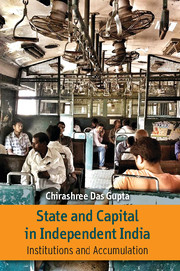Book contents
- Frontmatter
- Dedication
- Contents
- Figures
- Tables
- Acknowledgements
- 1 Introduction
- 2 Globalization and Neoliberalism: The Context and the Debate
- 3 State and Capital in Independent India: The Problematic
- 4 Policy Regimes and Macroeconomic Outcomes: 1947–1966
- 5 Institutionalization of the Regime of Capital in India: 1947–1966
- 6 Continuity and Change in Capital Accumulation: 1966–1980
- 7 Sources of Accumulation: State Intervention and Non-intervention
- 8 ‘Old Oligopolies and New Entrants’ in the Pharmaceutical Sector
- 9 Conclusion
- Bibliography
- Index
4 - Policy Regimes and Macroeconomic Outcomes: 1947–1966
Published online by Cambridge University Press: 05 September 2016
- Frontmatter
- Dedication
- Contents
- Figures
- Tables
- Acknowledgements
- 1 Introduction
- 2 Globalization and Neoliberalism: The Context and the Debate
- 3 State and Capital in Independent India: The Problematic
- 4 Policy Regimes and Macroeconomic Outcomes: 1947–1966
- 5 Institutionalization of the Regime of Capital in India: 1947–1966
- 6 Continuity and Change in Capital Accumulation: 1966–1980
- 7 Sources of Accumulation: State Intervention and Non-intervention
- 8 ‘Old Oligopolies and New Entrants’ in the Pharmaceutical Sector
- 9 Conclusion
- Bibliography
- Index
Summary
The first two decades after independence in much of the existing literature is presented as a period in which planning and the license-control regime were established in India. The dominant neoclassical perspective in accounts of the Indian transition after independence has been focussed around the premise that planning, ISI and the licensing regime were the main constituents of the institutional structure that was installed in India after independence (Bhagwati, 1993; Srinivasan and Narayana, 1994; Bhagwati, 1998; Ahluwalia and Little, 1998; Bardhan, 1998; Das, 2000; Ahluwalia, 2002, etc.). The significance of this entire period is attributed in this literature to the fetters that planning, ISI and licensing created on capitalist expansion through the promotion of ‘rent-seeking’ and ‘directly unproductive profit-seeking activities’. This formed the ex-post rationale for deregulation of the economy. This rationale though dominant is open to questioning on several counts. This chapter puts forward three arguments contesting the dominant literature: first, this period did not constitute a single policy regime but multiple ones and hence the periodization of policy regimes has to be re-visited. Second, there is a conflation of policy and institution in these perspectives apart from historical inaccuracies. Once the periodization by policy regimes is examined, the shifts in regimes are found to be a response to the constraints on capital formation in India. Third, the outcomes that have led to a rejection of these policy regimes in the literature cannot be explained only within the specificities of the Indian planning (and ISI) and licensing regime in the period between 1947 and 1965. For example, the expansions on Indian capital abroad in different countries with different policy regimes in this period mostly met with failure. Therefore, specificity of policy regimes cannot be the explanans for such outcomes spread across different policy variants. Thus, our contention is that the explanation of the outcomes cannot be wholly attributed to the specificities of either India's licensing or planning regime. The outcomes can be better explained through the characteristic of the institutional structure of the regime of accumulation in India that was installed in this period.
Section 4.1 demonstrates that the structural conditions at independence led to a consensus between the state and organizations of capital on the contours of state-led capitalist development in India.
- Type
- Chapter
- Information
- State and Capital in Independent IndiaInstitutions and Accumulations, pp. 78 - 111Publisher: Cambridge University PressPrint publication year: 2016



